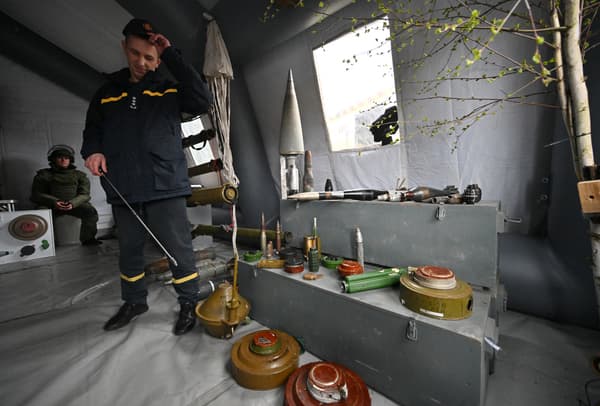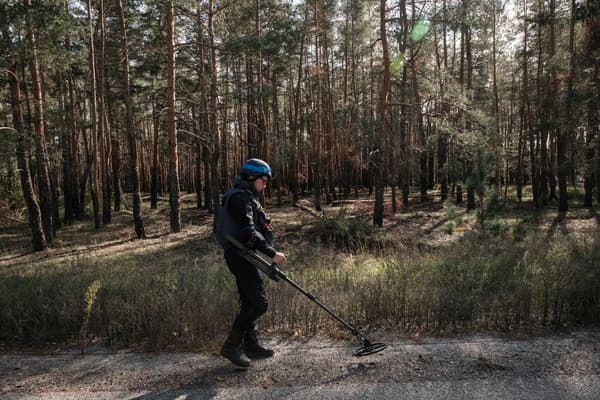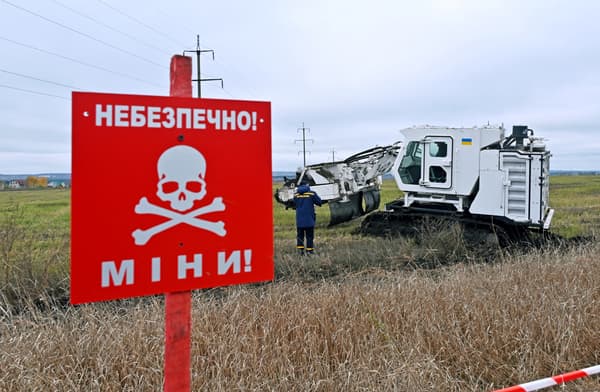the
Returning to normal life will take time in Kherson. The Russians “left behind thousands of mines and unexploded ordnance,” Volodymyr Zelensky warned. The day after the recapture of the city, annexed by Moscow at the end of September, the special forces were already in action to try to neutralize them, he explained. president of Ukraine Last weekend.
Among the weapons used by Russia in the invasion of Ukraine, kyiv has repeatedly reported that Russian soldiers had mined its territories before withdrawing. This practice of warfare is not new, but it is devastating, so much so that many countries have banned it.
Because “once the armies are withdrawn, the mines remain,” laments Marwan Nadim.
Then they constitute a mortal danger for years, laments this specialist in the reduction of armed violence for Handicap International, interviewed by BFMTV.com. “It is a weapon that affects without consideration” civilians or combatants, he adds.
More than 7,000 victims worldwide in 2020
By making no distinction between a soldier and a child, these mines go against The international rules of war require that civilians be spared. in conflicts. “At first, it is a weapon that serves to block an army” and prevent it from advancing and reaching a place, recalls Frédéric Joly, spokesman for the International Committee of the Red Cross (ICRC) in France. But when civilian areas are mined, it is obvious that the inhabitants will suffer.
Civilians remain “the main victims of these indiscriminate weapons”, writes Landmine Monitor in a 2021 report. According to its figures, the previous year, 7,073 people worldwide were victims of mines or explosive remnants of war, of which 2,492 died. Civilians account for more than 60% of the victims, with a high proportion of children affected.
And “all these figures are underestimates because the census is difficult in some places,” adds Marwan Nadim.
Even before the Russian offensive began in February, Ukraine was “one of the hardest-hit countries in the world,” the newspaper wrote in 2019. United Nations High Commissioner for Refugees. The country thus deplored 277 victims (injured or killed) of mines in 2020, while the current war had not started.
In fact, Ukraine has been “very undermined” since 2014 and the beginning of the conflict with Russia in Donbass, recalls Frédéric Joly.
Colombia and Cambodia are also frequently cited by experts on the subject: in 2020, 167 people were mine victims in Colombia, 65 in Cambodia. However, the vast majority of victims are in Afghanistan, with 1,474 people affected in a year.
A disarmament treaty, the ottawa convention, however it exists. Dated 1997, it considers a mine as “an artifact designed to be placed under or on the ground or other surface, or near it, and explode due to the presence, proximity or contact of a person or a vehicle”.
This convention obliges its signatories to “never, under any circumstances”, use, produce, buy or stockpile antipersonnel mines, which therefore target people. In short, these mines must disappear from the country, only a small stock can be maintained to continue training and training deminers.
More than 160 countries have signed it, including France and Ukraine, but not the United States, China or Russia, which explains the significant ongoing mining in Ukraine.

The interviewed experts also evoke the tragedy of cluster bombs: containers full of explosive mini-bombs that are dropped from the sky and can “contaminate a large area, this creates significant random contamination”, potentially in inhabited areas, explains Marwan Nadim.
The Oslo Convention, which entered into force in 2010, prohibits its use, but Russia and Ukraine are not signatories, and this weapon has been used in recent months in the conflict according to observers.
Moscow forces have used it “repeatedly … in attacks that have killed hundreds of civilians and damaged homes, hospitals and schools,” Human Rights Watch said in a report dated May. “Ukrainian forces have also used these types of weapons at least once,” added the NGO, which calls on the two countries to sign the Oslo Convention and put an end to the use of these weapons.
In fact, “up to 40% of submunitions fail to explode when they hit the ground,” he writes. International Handicap. Then they become “as dangerous as antipersonnel mines”: “They can explode at any time, with the slightest manipulation (…) These explosive remnants represent a threat to civilians, sometimes decades after a conflict.”
During armed fights, improvised explosive devices in mines also cause a lot of damage, like homemade mines or objects trapped with explosives.
In Syria, in certain territories, “everyday objects, kettles, pans, pillows, air conditioners, refrigerators or toys would also contain mines that are about to explode when people return after months or years away from home,” he told Doctors Without Borders in 2018. .
“These mines prolong war after war”
All these mines “have a simple mechanism that can remain functional for decades,” explains Marwan Nadim: the specialist points out that there are still mines from WWII in Egypt. In France, on the other hand, “usually there aren’t anymore”, but it just so happens thatold unexploded ordnance, such as projectiles.
“These mines prolong war after war,” Henry Zipper de Fabiani, a former ambassador in charge of humanitarian demining, told BFMTV.com.
With these weapons, “entire territories are frozen by fear, farmers cannot farm certain places, children can no longer play where they want”, at least during the time of demining.

Not to mention that this fear of being wounded or killed, which persists after the war, regularly reminds the population of past battles and the resulting traumas, which does not help to restore stability and peace. Therefore, the demining process is essential in this sense for a complete exit from a conflict, but it can be very long:
“One day of war leads to a month-long demining effort in certain territories,” said Denys Marchuk, vice-president of the Agrarian Council of Ukraine, for example.
demining mine by mine
Because, if “mining is done on a massive scale, demining is mine by mine,” recalls Frédéric Joly, knowing that certain places are difficult to access and that sometimes we don’t even know where the mines are.
In addition to the slowness that this exercise requires, it is an “extremely expensive” operation, says Marwan Nadim, “because it requires advanced technical and mechanical means, and there are few qualified personnel.” This is the reason why many countries are still heavily mined, decades after the end of the conflicts.
“I often heard that demining Ukraine would take decades,” Volodymyr Zelensky himself explained. “We can’t wait that long.”
To allow civilians to return to their city or move freely, demining efforts are already underway in certain Kyiv-occupied territories, such as the Kherson region. But the situation is still very unstable and the Moscow army is still nearby: therefore it is possible to clear the land that will later be potentially occupied and perhaps remined.
“The demining procedure has just started, but potentially the Kherson region could be the most mined region in the country,” said the guardian the Association of Minesweepers of Ukraine. The organization says it fears that Ukraine will become the country where mines are deadliest.
Media needed over time
To reduce the number of potential victims, “we need long-term allocated resources to continue decontamination actions,” says Marwan Nadim.
In the case of Ukraine, several countries have already made significant donations since the beginning of the war to enable demining. Thus, at the end of September, the US Department of State announced humanitarian aid of 47.6 million dollars (approximately 46 million euros). Others also propose training deminers to speed up work on the ground, as has been done, for example, by Belgium and Cambodia.
While waiting for the actual danger to be averted, populations must be alerted to the danger posed by these explosive devices. “The ICRC has been working in Ukraine since 2014 and one of our missions is to denounce the risk of mines” and to ask the local population, for example, “not to stray from the path”, explains Frédéric Joly.
This aspect is “very important,” says Fabiani’s Henry Zipper, because “these populations will have to live for years with this danger.”

Beyond Ukraine, there are still millions of mines scattered around the world, even as each year signatory states to the Ottawa convention announce new areas to be cleared. In 2020 they claimed to have cleared 146 km² of landmines and destroyed more than 135,500 antipersonnel mines. In 1999, around 160 million antipersonnel mines were stockpiled around the world, compared to 50 million today.
“So there are still a lot of usable mines,” warns Frédéric Joly.
“Real progress has been observed since the adoption of the Ottawa Treaty with a steady decline in the number of victims in the following years,” says Marwan Nadim. “However, the number of victims has been increasing since 2015, with the appearance of new major conflicts,” such as in Syria, or now in Ukraine.

Nelson’s investigation: The cartridge dog, star of demining in Ukraine – 04/21
Source: BFM TV

